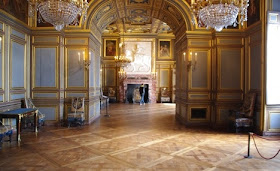Château de Fontainebleau, one of the most beautiful castles in France, located about sixty kilometres south-east of Paris, has witnessed eight unbroken centuries of sovereign rule. With over 1500 rooms at the heart of 130 acres of parkland and gardens, Fontainebleau is the only royal and imperial château to have been continuously inhabited for seven centuries.Kings and queens, and emperors and empresses, took great pains to embellish the palace, built around the original mediaeval dungeon. Fontainebleau is the creation of many kings, beginning with François I who assembled a group of Italian artists to transform a medieval fortress into a palace decorated in the Renaissance style.It's interior decorations are especially interesting as a fine example of the French Renaissance style.Louis XVI had several rooms, including the Queen’s bedchamber, redecorated for Marie-Antoinette, who did not have time to enjoy them. The royal family never returned to Fontainebleau after 1786.Napoleon chose to make Fontainebleau an imperial residence. Since the furniture had been sold during the Revolution, he refurnished the château in the Empire style, which is still predominant today.
www.frenchculturesfestival.com
By the late 18th century, the chateau had fallen into disrepair; during the French Revolution many of the original furnishings were sold, in the long Revolutionary sales of the contents of all the royal châteaux, intended as a way of raising money for the nation and ensuring that the Bourbons could not return to their comforts. Nevertheless, within a decade Emperor Napoleon Bonaparte began to transform the Château de Fontainebleau into a symbol of his grandeur, as an alternative to the empty Palace of Versailles
At Fontainebleau Napoleon bade farewell to his Old Guard and went into exile in 1814.
Enjoy the music as you tour the Chateau.
google.com
The Gallery It pre-dates the Apollo Gallery in the Louvre (post-1661) and the Hall of Mirrors in Versailles (post-1678).
The Gallery It pre-dates the Apollo Gallery in the Louvre (post-1661) and the Hall of Mirrors in Versailles (post-1678).
As spaces in which the Court could socialise and promenade, the galleries at the Château de Fontainebleau played a very important role. Only three now remain. Along with Louis Philippe’s Salle des Colonnes, and Napoleon III’s theatre, they have exceptionally opulent décor.
All the frescoes of the gallery are the work of Rosso, with the exception of the Danae, a work of Primaticcio, on the south wall in the center of the gallery.
Chapelle de la St Trinite, Chateau de Fontainebleau
It is here that Louis XV married Marie Leczinska in 1725 and Napoleon III was baptised in 1810.
The lower level of Chapelle de la St Trinite, Chateau de Fontainebleau
The Throne Room
Formerly the Queen Mothers’ apartment after the widowed Anne of Austria retired there. Named after the two visits which Pius VII made to it in 1804 and 1812-1814, it retains the title of Papal Apartment.
The Emperor's bedchamber
The Empress Chambers at Fountainbleu
The Empress Bed
State Bedrooms
As an alternative to the former royal Palace of Versailles, Fontainebleau is where renaissance architecture and the Italian Mannerist style of interior decoration were first introduced to France. Consequently, the French Mannerist style is known as the “Fontainebleau style”.
Like Versailles, Fontainebleau’s walls are sumptuously decorated with gold-leaf, large murals, heavy tapestries and elaborately carved exposed wood, stained in different shades.
The sovereign Grands Apartments. Visitors today will find it more or less as Napoleon III and Eugenie left it in 1868
The Library
Built to link the King’s Chamber to the gallery of the Trinitarian monks’ chapel, this gallery was originally lit from windows along both sides, until the wing was extended during Louis XVI’s reign.
The picture below is of this very hallway.
Napoleon III receiving the Siamese embassy at Fontainebleau (1864).
Entrance of the Louis XIII room
Gardens of the Palace of Fontainebleau : Diane fountain and its dogs made of bronze, flowers and trees of the Diane garden
clos-jarcy.wifeo.com
Click here to see the previous post!
This blog post was published by
Lisa Farmer



.jpg)





.jpg)





.jpg)







.jpg)



.jpg)






.JPG)





